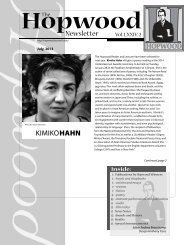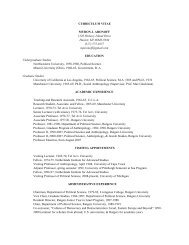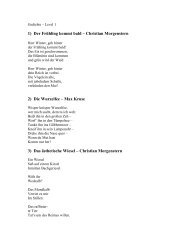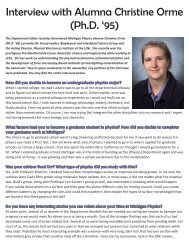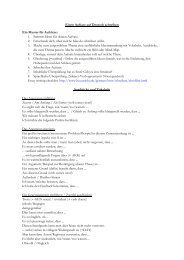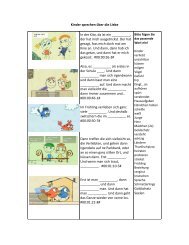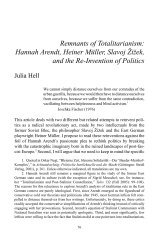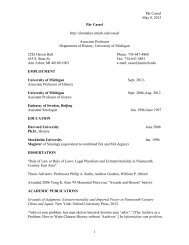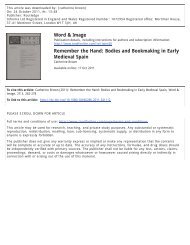The Joyful Mind - University of Michigan
The Joyful Mind - University of Michigan
The Joyful Mind - University of Michigan
You also want an ePaper? Increase the reach of your titles
YUMPU automatically turns print PDFs into web optimized ePapers that Google loves.
he<br />
<strong>Joyful</strong><br />
40 Scientific American, August 2012<br />
NeuroscieNce<br />
<strong>Mind</strong><br />
A new understanding <strong>of</strong> how the brain generates<br />
pleasure could lead to better treatment<br />
<strong>of</strong> addiction and depression—and even<br />
to a new science <strong>of</strong> happiness<br />
By Morten L. Kringelbach and Kent C. Berridge<br />
In the 1950s psychiatrist robert heath <strong>of</strong> tulane university<br />
launched a controversial program to surgically implant<br />
electrodes into the brains <strong>of</strong> patients institutionalized with<br />
epilepsy, schizophrenia, depression and other severe neurological<br />
conditions. His initial objective: to locate the biological<br />
seat <strong>of</strong> these disorders and, by artificially stimulating those regions,<br />
perhaps cure individuals <strong>of</strong> their disease.<br />
scientific american (photoillustration); getty images (head outline);<br />
thinkstock (images inside head); courtesy <strong>of</strong> nasa (moon)
According to Heath, the results were dramatic. Patients who<br />
were nearly catatonic with despair could be made to smile, converse,<br />
even giggle. But the relief was short-lived. When the<br />
stimulation ceased, the symptoms returned.<br />
To extend the potential therapeutic benefi t, Heath fi tted a<br />
handful <strong>of</strong> patients with buttons they could press themselves<br />
whenever they felt the urge. Some felt the urge quite frequently.<br />
One patient—a 24-year-old homosexual whom Heath was attempting<br />
to cure <strong>of</strong> depression (and <strong>of</strong> his desire for other<br />
men)—was compelled to stimulate his electrodes some 1,500<br />
times over the course <strong>of</strong> a single, three-hour session. According<br />
to Heath, this obsessive self-stimulation gave the subject, patient<br />
B-19, “feelings <strong>of</strong> pleasure, alertness, and warmth (goodwill).”<br />
<strong>The</strong> end <strong>of</strong> his session was met with vigorous protest.<br />
<strong>The</strong> experiments helped to defi ne a set <strong>of</strong> structures that<br />
would come to be known as the “pleasure center” <strong>of</strong> the brain.<br />
<strong>The</strong>y also spawned a movement—both in science and in popular<br />
culture—to better understand the biological basis <strong>of</strong> pleasure.<br />
Over the next 30 years neurobiologists identifi ed the<br />
chemicals that the brain regions delineated by Heath and others<br />
send and receive to spread their tidings <strong>of</strong> joy. And people<br />
began to imagine brave new worlds in which activation <strong>of</strong> these<br />
centers could produce instant bliss.<br />
Yet the discovery <strong>of</strong> the brain’s alleged pleasure center has<br />
not led to any breakthroughs in the treatment <strong>of</strong> mental illness.<br />
It may have even misled scientists into thinking they understood<br />
how pleasure is encoded and generated within the brain.<br />
Studies in rodents and humans now suggest that activating<br />
these structures with electrodes or chemicals does not actually<br />
produce pleasure at all. It may merely precipitate craving and<br />
hence the manic drive to self-stimulate.<br />
With the help <strong>of</strong> modern molecular biological techniques,<br />
combined with improved methods for deep-brain stimulation,<br />
our laboratories and others are redefi ning the brain’s pleasure<br />
circuitry. We are fi nding that the pleasure-generating systems<br />
in the brain are much more restricted—and much more complex—than<br />
previously thought. By pinpointing the true neurological<br />
underpinnings <strong>of</strong> pleasure, we hope to pave the way to<br />
more targeted and e� ective treatments for depression, addiction<br />
and other disorders—and perhaps to o� er new insights into<br />
the roots <strong>of</strong> human happiness.<br />
MISLEADING ELECTRODES<br />
WHETHER EXPERIENCED as shivers <strong>of</strong> delight or the warm thrum <strong>of</strong><br />
contentment, pleasure is more than an ephemeral extra—that<br />
is, something to be sought only after one’s more basic needs<br />
have been met. <strong>The</strong> sensation is actually central to life. Pleasure<br />
nourishes and sustains animals’ interest in the things they need<br />
to survive. Food, sex and, in some cases, social communion generate<br />
positive feelings and serve as natural rewards for all animals,<br />
including ourselves.<br />
New research has uncovered hotspots<br />
in the brain that, when stimulated, enhance<br />
sensations <strong>of</strong> pleasure.<br />
<strong>The</strong>se hedonic hotspots diff er from the<br />
42 Scientifi c American, August 2012<br />
“reward circuit” previously thought to<br />
be the basis <strong>of</strong> good feelings—a pathway<br />
now believed to mediate desire<br />
more than enjoyment.<br />
IN BRIEF<br />
Morten L. Kringelbach is director <strong>of</strong> Hedonia:<br />
TrygFonden Research Group at at the <strong>University</strong> <strong>of</strong> Oxford<br />
and Aarhus <strong>University</strong> in Denmark. He serves on<br />
Scientifi c American’s board <strong>of</strong> advisers.<br />
Kent C. Berridge is James Olds Collegiate<br />
Pr<strong>of</strong>essor <strong>of</strong> Psychology and Neuroscience at the<br />
<strong>University</strong> <strong>of</strong> <strong>Michigan</strong>.<br />
<strong>The</strong> fi rst apparent insights into the biological basis <strong>of</strong> these<br />
feelings came nearly 60 years ago from the original discoverers<br />
<strong>of</strong> the so-called pleasure electrodes. James Olds and Peter Milner<br />
<strong>of</strong> McGill <strong>University</strong> were searching for brain regions that<br />
could infl uence animal behavior. Earlier studies from Yale <strong>University</strong>—in<br />
which electrodes had been inserted into rats’<br />
brains—had identifi ed an area that, when stimulated, would<br />
cause an animal to avoid whatever action had coincided with<br />
the stimulation. While trying to replicate these fi ndings, Olds<br />
and Milner came across a brain region that the rodents would<br />
take active steps to stimulate—in the same way that animals<br />
will repeat any task or behavior that yields a suitable reward.<br />
Placing the electrodes in di� erent regions—and sometimes<br />
not where they intended—the pair were surprised to fi nd a part<br />
<strong>of</strong> the brain that animals seemed to enjoy having zapped with a<br />
mild electric current. Rats placed in a large box returned repeatedly<br />
to the corner in which the researchers would give them a<br />
small electric jolt. Using this approach, Olds and Milner found<br />
they could steer the rodents to almost any location. In some instances,<br />
the animals even chose stimulation over food. If the researchers<br />
pressed the button when the rats were halfway<br />
through a maze that promised a tasty mash at the end, the creatures<br />
simply stayed put, never bothering to proceed to the treat.<br />
Even more surprising, when the electrodes were wired so<br />
that the rats could stimulate their own brain by pressing a lever,<br />
Olds and Milner discovered that they did so almost obsessively—<br />
some more than 1,000 times an hour [see “Pleasure Centers in<br />
the Brain,” by James Olds; SCIENTIFIC AMERICAN, October 1956].<br />
When the current was turned o� , the animals would press the<br />
bar a few more times—and then go to sleep.<br />
<strong>The</strong> results prompted Olds and Milner to declare, “We have<br />
perhaps located a system within the brain whose peculiar function<br />
is to produce a rewarding e� ect on behavior.” <strong>The</strong> regions<br />
the researchers identifi ed—including the nucleus accumbens,<br />
which reclines at the base <strong>of</strong> the forebrain, and the cingulate<br />
cortex, which forms a collar around the fi brous bundle that<br />
bridges the brain’s left and right halves—thus became enshrined<br />
as the operational base <strong>of</strong> the brain’s reward circuit.<br />
Almost immediately other scientists reproduced these ef-<br />
Higher brain regions receive information<br />
from these pleasure and reward circuits<br />
to consciously represent the warm<br />
glow we associate with joy.<br />
A decoupling <strong>of</strong> the brain systems that<br />
generate “wanting” and “liking” may<br />
underlie addictive behavior—a clue that<br />
may lead to new treatments.
ANATOMY OF JOY<br />
Paths to Pleasure<br />
Pleasure is a complex experience that encompasses everything<br />
from anticipation and desire to sensation and satisfaction.<br />
So it’s no surprise that several brain regions work together to<br />
generate this warm glow <strong>of</strong> good feeling.<br />
Wanting and Liking<br />
A neural circuit (blue) that begins<br />
near the brain stem and reaches out<br />
to the forebrain was once thought to<br />
be the sole mediator <strong>of</strong> pleasure. But<br />
it is actually more focused on desire.<br />
In addition to this pathway, several<br />
so-called hedonic hotspots, including<br />
two shown here (red), interact to create<br />
a sense <strong>of</strong> liking. A quilt <strong>of</strong> cortical<br />
regions (pink) then translates infor mation<br />
received from the “wanting” and<br />
“liking” circuits into con scious plea sure<br />
and adjusts this feeling based on inputs<br />
from other brain regions.<br />
Enkephalin<br />
Terminal <strong>of</strong><br />
a neuron<br />
Anandamide<br />
receptor<br />
Enkephalin<br />
receptor<br />
Cingulate<br />
cortex<br />
Anandamide<br />
fects, making similar fi ndings in higher primates and humans.<br />
Heath, in particular, pushed the interpretation <strong>of</strong> his results to<br />
the limit, insisting that stimulating these regions not only reinforces<br />
a behavior but produces sensations <strong>of</strong> euphoria. In the<br />
minds <strong>of</strong> many scientists and the general public, these structures<br />
became known as the brain’s chief pleasure center.<br />
About 10 years ago, though, the two <strong>of</strong> us began wondering<br />
whether the act <strong>of</strong> electrical self-stimulation was really the best<br />
measure <strong>of</strong> pleasure. How do we know that subjects stimulate<br />
those regions because they like the way it feels and not for some<br />
other reason? To probe the pleasure circuitry more precisely, we<br />
Illustration by AXS Biomedical Animation Studio<br />
Interpret<br />
and<br />
modulate<br />
Orbit<strong>of</strong>rontal<br />
cortex<br />
Insular cortex<br />
Nucleus<br />
accumbens<br />
Ventral pallidum<br />
Amygdala<br />
<strong>The</strong> Chemistry <strong>of</strong> Liking<br />
Within a hedonic hotspot, a pair <strong>of</strong> intoxicating<br />
neurotransmitters cooperate to enhance feelings<br />
Neighboring <strong>of</strong> pleasure. An enjoyable stimulus, such as a sweet treat,<br />
neuron<br />
prompts a neuron in the area (top) to release enkephalin,<br />
an opioid made in the brain. Enkephalin interacts with<br />
receptor proteins on a neighboring neuron (bottom),<br />
potentially triggering production <strong>of</strong> anandamide, the brain’s<br />
version <strong>of</strong> marijuana. As anandamide diff uses away from<br />
its site <strong>of</strong> synthesis, it can interact with receptors on the fi rst<br />
neuron, intensifying the sensation <strong>of</strong> pleasure and perhaps even<br />
stimulating the production <strong>of</strong> more enkephalin. Together these<br />
chemicals form a pleasure-boosting loop <strong>of</strong> liking.<br />
Ventral<br />
tegmental<br />
area<br />
Wanting<br />
Liking<br />
Conscious pleasure<br />
felt we needed to devise a di� erent way <strong>of</strong> assessing what subjects—including<br />
animals—actually enjoy.<br />
A MEASURE OF PLEASURE<br />
FOR EXPERIMENTS IN PEOPLE, assessing pleasure is fairly straightforward:<br />
just ask. Of course, the resulting ratings might not fully<br />
capture or accurately refl ect the underlying sensations. Further,<br />
such inquisition is not possible in laboratory animals—the<br />
subjects in which biology is most easily explored.<br />
An alternative approach takes its lead from Charles Darwin.<br />
In his 1872 book <strong>The</strong> Expression <strong>of</strong> the Emotions in Man and An-<br />
August 2012, Scientifi cAmerican.com 43
imals, Darwin noted that animals change their affect in response<br />
to environmental situations—in other words, they make faces.<br />
We now know that the neural mechanisms underlying such expressions<br />
work similarly in most mammalian brains. Hence, certain<br />
facial gestures have been conserved in animals as distantly<br />
related as rodents and humans—including the “yummy faces”<br />
we make in response to tasty food.<br />
Food is one <strong>of</strong> the most universal routes to pleasure—as well<br />
as an essential requirement for survival. It is also one <strong>of</strong> the<br />
most accessible experimental tools used by psychologists and<br />
neuroscientists studying animal behavior. In our studies, we<br />
have found that the response to food provides a window through<br />
which we can observe unspoken pleasures.<br />
Anyone who has spent time around babies knows that even<br />
the youngest humans have ways <strong>of</strong> advising their caregivers<br />
about the palatability <strong>of</strong> a meal. Sweet tastes elicit a contented<br />
licking <strong>of</strong> the lips, whereas bitter tastes tend to be met with gaping<br />
mouths, shaking heads and a vigorous wiping <strong>of</strong> the mouth.<br />
<strong>The</strong> same responses seen in human infants also occur in rats,<br />
mice and nonhuman primates. <strong>The</strong> more sub<br />
jects like the taste, the more <strong>of</strong>ten they will lick<br />
their lips. By making video recordings <strong>of</strong> subjects’<br />
responses to food and then counting the<br />
number <strong>of</strong> times their tongues dart out—as if to<br />
capture every last molecule <strong>of</strong> flavor—we can<br />
measure how much a given gustatory stimulus is<br />
liked. And we have used that information to assess<br />
where pleasure really resides in the brain.<br />
Wanting is not Liking<br />
one <strong>of</strong> the first things we discovered is that<br />
pleasure does not arise in the brain quite where—<br />
or how—past thinking said it should. <strong>The</strong> regions<br />
first identified by Olds and Milner and others,<br />
positioned at the front <strong>of</strong> the brain, are activated<br />
by the neurotransmitter dopamine, released by<br />
neurons that originate near the brain stem. If<br />
these frontal areas truly regulate pleasure, we<br />
reasoned, flooding them with dopamine—or removing<br />
dopamine entirely—should alter how an animal responds<br />
to an enjoyable stimulus. That is not what we found.<br />
For these experiments, our colleague Xiaoxi Zhuang <strong>of</strong> the <strong>University</strong><br />
<strong>of</strong> Chicago engineered mice lacking a protein that retrieves<br />
dopamine once it has been released by an excited neuron, returning<br />
the neurotransmitter to the cell’s interior. Animals with such<br />
a knockout mutation maintain unusually high concentrations <strong>of</strong><br />
dopamine throughout their brain. Yet we found that the mice do<br />
not appear to derive more pleasure from sweets than their unaltered<br />
cage mates do. Relative to normal rodents, the dopaminedoped<br />
mice do speed more quickly toward sweet rewards; however,<br />
they do not lick their lips any more <strong>of</strong>ten. On the contrary, they<br />
do so even less than mice with average amounts <strong>of</strong> dopamine.<br />
We see the same thing in rats that have dopamine elevated<br />
by other means. For example, injecting amphetamine into the<br />
nucleus accumbens causes dopamine in that area to rise. Again,<br />
however, sugary treats seem no more pleasant to these rats after<br />
their chemically assisted dopamine boost—although the animals<br />
are more motivated to obtain them.<br />
Conversely, rats that have been depleted <strong>of</strong> their dopamine<br />
44 Scientific American, August 2012<br />
show no desire for sugary treats at all. <strong>The</strong>se animals will actually<br />
starve to death unless they are actively nursed. Yet dopaminefree<br />
rats that have no interest in food nonetheless find whatever<br />
sweets might be placed into their mouth whiskerlicking good.<br />
So it seems that dopamine’s effects may be subtler than previously<br />
understood. <strong>The</strong> chemical appears to contribute more to<br />
motivation than to the actual sensation <strong>of</strong> pleasure itself. In humans,<br />
too, dopamine levels appear to track more closely with<br />
how much individuals claim to “want” a delicious tidbit than<br />
with how much they say they “like” it.<br />
<strong>The</strong> same may be true in addiction. Drugs <strong>of</strong> abuse flood the<br />
brain with dopamine—particularly those regions associated with<br />
“wanting.” This dopamine barrage not only triggers intense craving,<br />
it renders cells in these regions more sensitive to future drug<br />
exposure. Moreover, work from our colleague Terry Robinson <strong>of</strong><br />
the <strong>University</strong> <strong>of</strong> <strong>Michigan</strong> suggests that this sensitization can<br />
persist for months or years. Thus, even after the drug no longer<br />
brings pleasure, Robinson reasons, an addict can still feel a strong<br />
urge to use—an unfortunate consequence <strong>of</strong> dopamine’s actions.<br />
Given this new understanding, we believe<br />
Pleasure<br />
does not<br />
arise in<br />
the brain<br />
quite<br />
where—or<br />
how—past<br />
thinking<br />
said it<br />
should.<br />
that the “pleasure” electrodes that stimulate<br />
accumulation <strong>of</strong> this chemical in the brains <strong>of</strong><br />
rats—and humans—might not have been as<br />
enjoyable as was originally assumed. In support<br />
<strong>of</strong> this view, we find that activation <strong>of</strong><br />
electrodes that elevate dopamine in the nucleus<br />
accumbens will motivate a rat to eat and<br />
drink, yet the same stimulation does not make<br />
that food more pleasing—just the opposite.<br />
Rats that are moved to eat sweets by electrical<br />
stimulation wipe their mouth and shake their<br />
head—signs <strong>of</strong> active dislike, as if the current<br />
had rendered the sweetness bitter or disgusting<br />
to them. <strong>The</strong> fact that the electrodes compel<br />
rats to consume large quantities <strong>of</strong> a food<br />
that is not bringing them pleasure is evidence<br />
that wanting and liking are controlled by different<br />
mechanisms in the brain.<br />
We think the differential control also occurs<br />
in humans. <strong>The</strong> application <strong>of</strong> current through the classic<br />
pleasure electrodes led at least one patient to a strong desire to<br />
drink. In others, including B19, electrical stimulation triggered<br />
an urge for sex. At the time, such sexual cravings were considered<br />
evidence <strong>of</strong> pleasure. Yet in our extensive reviews <strong>of</strong> the literature,<br />
we have never come across evidence that a patient implanted<br />
with these electrodes found them expressly pleasurable.<br />
B19 never once exclaimed, “Oh, that feels nice!” Instead stimulation<br />
<strong>of</strong> the pleasure electrodes simply made him and the others<br />
want more stimulation—probably not because they liked it<br />
but because they were made to desire it.<br />
Hedonic Hotspots<br />
wanting and liking are both involved in making an experience<br />
feel rewarding. So it makes sense that the real pleasure centers in<br />
the brain—those directly responsible for generating pleasurable<br />
sensations—turn out to lie within some <strong>of</strong> the structures previously<br />
identified as part <strong>of</strong> the reward circuit. One <strong>of</strong> these socalled<br />
hedonic hotspots lies in a subregion <strong>of</strong> the nucleus accumbens<br />
called the medial shell. A second is found within the ventral
pallidum, a deep-seated structure near the base <strong>of</strong> the forebrain<br />
that receives most <strong>of</strong> its signals from the nucleus accumbens.<br />
To locate these hotspots, we searched for brain regions that,<br />
when stimulated, amplify the sensation <strong>of</strong> pleasure—for example,<br />
making sweet things even more enjoyable. Chemically stimulating<br />
these hotspots with enkephalin—a morphinelike substance<br />
made in the brain—enhances a rat’s liking <strong>of</strong> sweets.<br />
Anandamide, the brain’s version <strong>of</strong> the active ingredient in marijuana,<br />
does the same. Another hormone called orexin, which is<br />
released by the brain during hunger, may also stimulate hedonic<br />
hotspots, helping to enhance the flavor <strong>of</strong> food.<br />
Each <strong>of</strong> these spots is just a fraction <strong>of</strong> the size <strong>of</strong> the larger<br />
structure in which it lies—only about one cubic millimeter in a<br />
rat brain and probably no more than a cubic centimeter in a human.<br />
Yet like the islands <strong>of</strong> an archipelago, they link to one another—and<br />
to other brain regions that process pleasure signals—to<br />
form a powerful, integrated pleasure circuit.<br />
That circuit is fairly resilient. In our experience, disabling individual<br />
components within the pleasure circuit does not diminish<br />
the typical response to a standard sweet—with one exception.<br />
Damaging the ventral pallidum appears to eliminate an<br />
animal’s ability to enjoy food, turning a nice taste nasty.<br />
On the other hand, intense euphoria is harder to come by<br />
than everyday pleasures. <strong>The</strong> reason may be that strong enhancement<br />
<strong>of</strong> pleasure—like the chemically induced pleasure<br />
bump we produced in lab animals—seems to require activation<br />
<strong>of</strong> the entire network at once. Defection <strong>of</strong> any single component<br />
dampens the high.<br />
Whether the pleasure circuit—and in particular, the ventral<br />
pallidum—works the same way in humans is unclear. Not many<br />
people come to the clinic with discrete damage to these structures<br />
without injuries in surrounding areas. Thus, it is difficult to<br />
assess whether the ventral pallidum and other components in<br />
the circuit are essential to the sensation <strong>of</strong> pleasure in humans.<br />
We know <strong>of</strong> one patient whose ventral pallidum became damaged<br />
during a massive drug overdose. Afterward, he reported that<br />
his feelings were dominated by depression, hopelessness, guilt<br />
and an inability to feel pleasure—potentially supporting a central<br />
role for this heret<strong>of</strong>ore underappreciated structure.<br />
Enough Is Enough<br />
the circuit does not act alone in regulating feelings <strong>of</strong> joy. To add<br />
that warm gloss <strong>of</strong> pleasure to a sensation or experience, additional<br />
brain regions come into play. <strong>The</strong>se higher structures help<br />
to determine how delightful an experience is, based on current<br />
conditions, such as whether one is hungry or full or has simply<br />
had enough <strong>of</strong> one particular pleasure. After eating an entire pan<br />
<strong>of</strong> brownies, for example, even an admitted chocoholic tends to<br />
find a candy bar much less appealing.<br />
In the case <strong>of</strong> food, such selective satiety may have evolved in<br />
part because it encourages animals to obtain a wide variety <strong>of</strong><br />
nutrients rather than fixating on one favorite meal. It seems to<br />
be encoded in a part <strong>of</strong> the brain called the orbit<strong>of</strong>rontal cortex.<br />
This area, located in the underbelly <strong>of</strong> the prefrontal cortex,<br />
which in humans hangs just above the eyes, receives information<br />
from the nucleus accumbens and ventral pallidum. It seems to<br />
modulate how pleasure is consciously represented—suffusing a<br />
sensation with that delicious glow we associate with gratification<br />
and toning down the feelings when enough is enough.<br />
With the help <strong>of</strong> powerful neuroimaging techniques, we have<br />
found that the activity <strong>of</strong> a small region within the orbit<strong>of</strong>rontal<br />
cortex, called the midanterior site, correlates tightly with the<br />
subjective pleasantness <strong>of</strong> a nice sensation, such as the taste <strong>of</strong><br />
chocolate milk. At the first sip, for example, the site is alight with<br />
activity. Yet once subjects have consumed enough <strong>of</strong> the sweet<br />
stuff, the midanterior site shuts down, rendering the experience<br />
no longer pleasurable.<br />
Further evidence that the midanterior site is important for<br />
human pleasure comes from studies <strong>of</strong> therapeutic deep-brain<br />
stimulation [see “Sparking Recovery with Brain ‘Pacemakers,’”<br />
by Morten L. Kringelbach and Tipu Z. Aziz; Scientific American<br />
<strong>Mind</strong>, December 2008/January 2009]. <strong>The</strong> procedure is being<br />
used to treat a few conditions, including to relieve suffering in<br />
patients with otherwise untreatable chronic pain. In one patient<br />
<strong>of</strong> ours, an amputee who was feeling pain in his missing limb,<br />
stimulation <strong>of</strong> an area within the brain stem not only relieved<br />
the pain but induced deep feelings <strong>of</strong> pleasure. Simultaneous<br />
neuroimaging revealed a burst <strong>of</strong> activity in the midanterior site<br />
as well. Whether such stimulation <strong>of</strong> specific hotspots in the<br />
pleasure system can be used to treat depression or other forms <strong>of</strong><br />
anhedonia—an inability to experience pleasure—remains an active<br />
area <strong>of</strong> investigation.<br />
Similarly, additional research may reveal how the circuits<br />
that govern pleasure and reward are linked. Under normal circumstances,<br />
the hedonic hotspots are coupled with the dopamine-driven<br />
reward system, such that we desire things that<br />
make us feel good and avoid or are indifferent to things that do<br />
not. In the case <strong>of</strong> addiction, these systems somehow become<br />
disconnected, causing the individual to continue to crave things<br />
that no longer bring pleasure. Such dissociation might also possibly<br />
contribute to other types <strong>of</strong> compulsive behaviors, such as<br />
binge eating and gambling. Understanding how and why such<br />
uncoupling can occur could reveal better ways to reverse the<br />
brain changes that drive addiction, thus restoring the natural<br />
alignment between wanting and liking.<br />
Aristotle once observed that happiness consists <strong>of</strong> two key ingredients:<br />
hedonia, or pleasure, plus eudaimonia—a sense <strong>of</strong><br />
meaning. Although scientists have made some progress in uncovering<br />
the biological basis <strong>of</strong> hedonia, we know very little<br />
about how the brain gives rise to a broader sense <strong>of</strong> a life well<br />
lived. We hope, however, that with time this puzzle, too, can be<br />
solved and that the discoveries will help people unite pleasure<br />
and purpose, elevating everyday experiences to something truly<br />
satisfying, perhaps even sublime.<br />
more to explore<br />
A Common Neurobiology for Pain and Pleasure. Siri leknes and Irene tracey in Nature<br />
Reviews Neuroscience, Vol. 9, pages 314–320; April 2008.<br />
<strong>The</strong> Pleasure Center: Trust Your Animal Instincts. morten l. Kringelbach. oxford <strong>University</strong><br />
press, 2008.<br />
Pleasures <strong>of</strong> the Brain. edited by morten l. Kringelbach and Kent C. Berridge. oxford <strong>University</strong><br />
press, 2010.<br />
Building a Neuroscience <strong>of</strong> Pleasure and Well-Being. Kent C. Berridge and morten l.<br />
Kringelbach in Psychology <strong>of</strong> Well-Being: <strong>The</strong>ory, Research, and Practice, Vol. 1, No. 3; october<br />
2011. www.psywb.com/content/1/1/3<br />
SCIENTIFIC AMERICAN ONLINE<br />
Watch a video <strong>of</strong> infants, nonhuman primates and rats showing pleasure and displeasure<br />
at ScientificAmerican.com/aug2012/pleasure<br />
August 2012, ScientificAmerican.com 45



